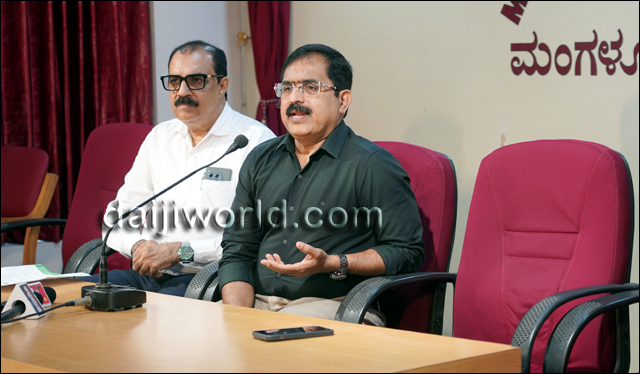Daijiworld Media Network – Mangaluru
Mangaluru, Jul 23: In yet another milestone, Indiana Hospital & Heart Institute, renowned for its advanced Structural Heart Disease Programme, has successfully performed two valve-in-valve TAVR procedures in Mangaluru, marking the first time such complex procedures have been conducted in the city.
Dr Yusuf Kumble, chief interventional cardiologist and managing director of Indiana Hospital, addressed the media at a press meet about the rare cardiac procedures.


Indiana has been a pioneer in structural heart disease treatment for the past six years and is now poised to celebrate the sixth anniversary of launching the region's first Structural Heart Programme, serving coastal Karnataka, North Malabar, and the Malnad region. It is worth recalling that about four years ago, Indiana Hospital performed Karnataka's first structural valve-in-valve procedure. However, valve-in-valve TAVR — a more advanced, minimally invasive technique — had never been performed in Mangaluru until now. That changed this week.
What is valve-in-valve TAVR?
Patients with severe aortic valve disease typically undergo surgical aortic valve replacement (SAVR). Over time, often after 10 to 15 years, these surgically implanted valves can degenerate and become dysfunctional. Replacing the valve again usually requires open-heart surgery, which carries significant risks — especially in elderly patients — due to previous surgeries, adhesions, clots, and fibrotic tissue.
To avoid the risks of reopening the chest, modern cardiac care now offers a minimally invasive solution called Valve-in-Valve TAVR (Transcatheter Aortic Valve Replacement). This technique involves placing a new valve inside the failing bioprosthetic valve using a catheter inserted through an artery — without open-heart surgery. Though similar to a routine TAVR, the valve-in-valve procedure is more technically challenging and riskier.
Case of a 72-year-old high-risk patient
A 72-year-old obese male, weighing 110 kg, with multiple comorbidities including diabetes mellitus, hypertension, and heart failure, approached Indiana Hospital. He had undergone surgical aortic valve replacement (SAVR) in Kochi nearly 20 years ago. Now presenting with heart failure symptoms, he was advised to undergo another valve replacement surgery.
However, due to the high surgical risk, multiple hospitals — including some in Kochi — declined to perform the procedure. The patient, unwilling to undergo another open-heart surgery, consulted several doctors across Karnataka and finally approached Dr Yusuf Kumble, managing director and chief interventional cardiologist at Indiana Hospital.
After a thorough evaluation, Dr Yusuf recommended valve-in-valve TAVR as a safer, less invasive alternative.
Double challenge: Valve replacement and angioplasty
An angiogram revealed that the patient also had significant coronary artery blockages, further complicating the case. The team at Indiana decided to address both conditions simultaneously.
First, they performed angioplasty to treat the coronary blockages contributing to his heart failure. This was immediately followed by the valve-in-valve TAVR procedure. This complex case was managed by a highly skilled multidisciplinary team led by Dr Yusuf A. Kumble (chief interventional cardiologist, managing director - IHHI) and included Dr Garry Valerian Pais (consultant interventional cardiologist), Dr Akash G. Nair (consultant interventional cardiologist), Dr Sukhen N Shetty (consultant cardiac anaesthesiologist), Dr Lath (cardiology medical officer), and technical expert Vijin (manager - Cath Lab, Indiana Group).
Second case: 80-year-old woman with recurrent heart failure
On the same day, Indiana Hospital also treated an 80-year-old woman who had undergone aortic valve replacement 20 years ago. Her valve had since degenerated, leading to repeated hospital admissions with recurrent heart failure. Despite being advised to undergo another surgery, no cardiac surgeon was willing to operate due to her age and high-risk profile.
Although hesitant initially, the patient agreed to the procedure after learning that another high-risk valve-in-valve TAVR was being successfully performed the same day. Encouraged by the expertise and care at Indiana, she gave her consent.
She underwent the procedure one hour after the first patient, marking a back-to-back success for Indiana's structural heart team.
Both procedures were completed successfully, and both patients were discharged in stable condition, showing excellent signs of recovery.
Regional center of excellence
This remarkable achievement once again reaffirms Indiana Hospital & Heart Institute’s status as a regional leader in TAVR/TAV and structural heart care. For high-risk patients across Karnataka and North Kerala, Indiana is rapidly becoming a beacon of hope.
The successful completion of these dual valve-in-valve TAVR procedures highlights not only Indiana’s technical excellence and clinical leadership but also its patient-first philosophy — bringing cutting-edge treatments to those who previously had no options.